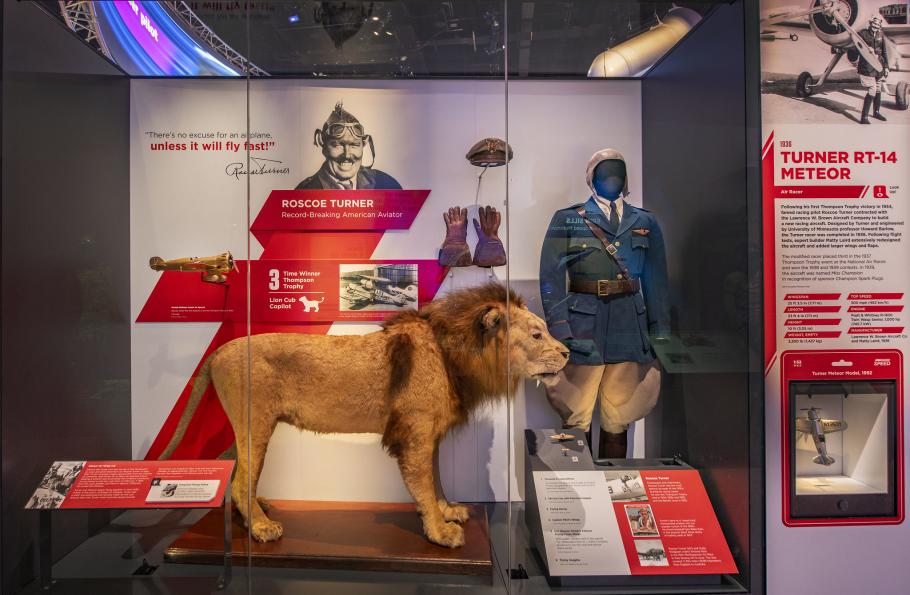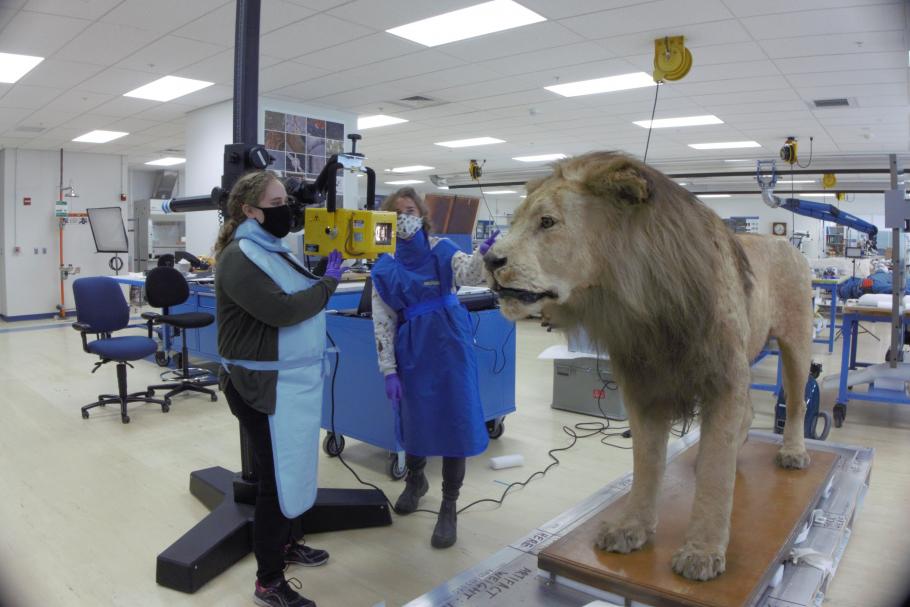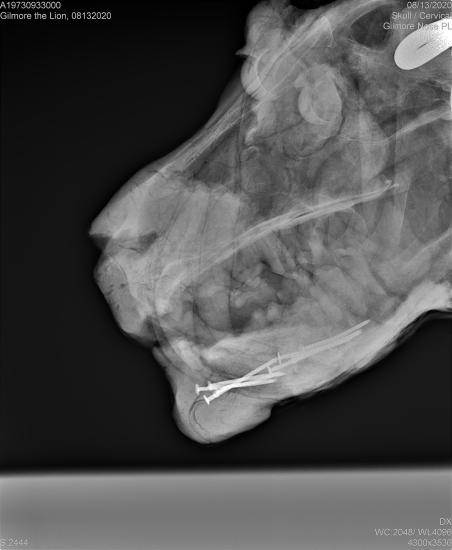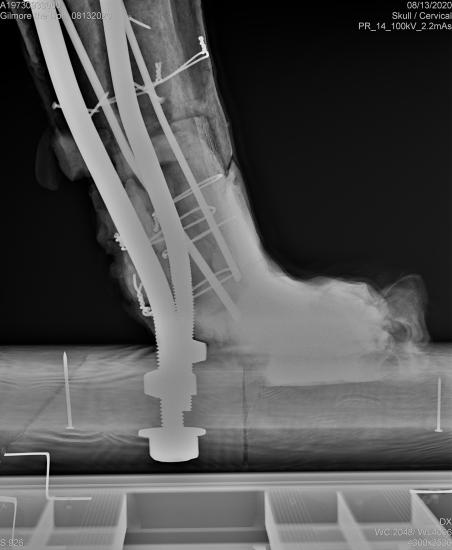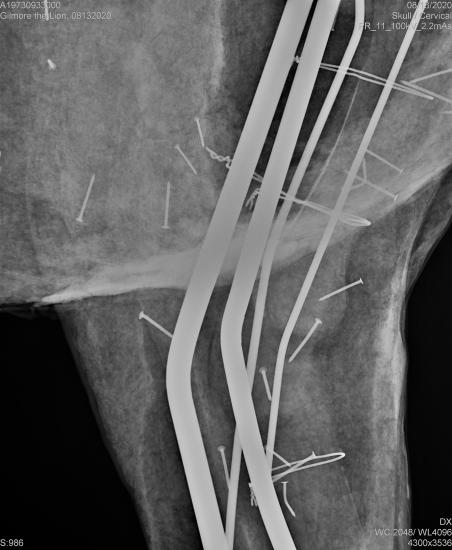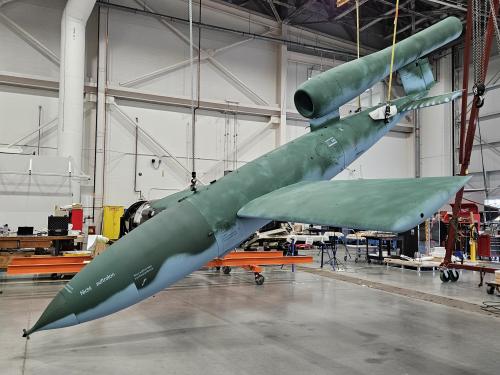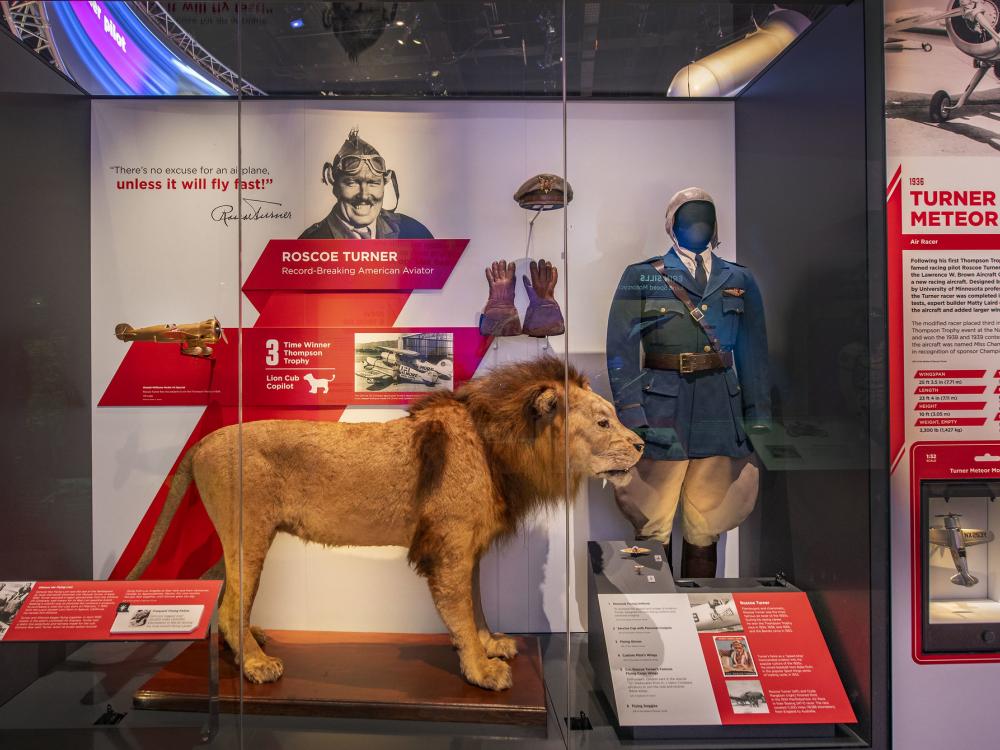
Conservation Treatment of Gilmore the Flying Lion: Examination
Feb 07, 2023
By Karen Wilcox, Lauren Horelick, Meredith Sweeney, Jeremy Kinney
Why is there a lion in the Smithsonian’s National Air and Space Museum collection? In a Museum known for its aviation and space-related artifacts, there is a unique piece of flying history: a taxidermy male African Lion—more fondly known as Gilmore the Flying Lion. As a cub in the 1930s, Gilmore made aviation history when he traveled around the United States with the flamboyant and colorful aviator Roscoe Turner as a mascot for the Gilmore Oil Company. They flew over 25,000 miles together until the big cat outgrew his spot in the aircraft. Gilmore the Flying Lion is now on display in the new Nation of Speed gallery at the Museum in Washington, D.C. Before he could be displayed, we needed to address condition issues such as extensive fur loss, light damage, and previous repairs.
Gilmore preserved and on display in the new Nation of Speed gallery. (Smithsonian Institution)
This is the first post in a three-part blog series about the conservation of Gilmore the Flying Lion. Here we will detail discoveries made during our initial examination into this unique object’s construction, previous repairs, and his current condition. In the next posts, we will explore how these factored into our treatment approach.
Assessing for Hazards
In the past, pesticides were commonly applied to taxidermy to prevent pest damage, and it is important to determine if any are present before working with natural history specimens. These pesticides could be made with heavy metals, such as arsenic, mercury, or lead, or be an organic spray, such as DDT.
Several spots across Gilmore’s hide, fur, and mane were analyzed using X-ray fluorescence spectroscopy. This is a technique for identifying the elemental components within a material– including the presence of any heavy metals. Lead or mercury were not present, but we did find arsenic. This meant we had to take care to use appropriate protection when working with Gilmore. To better understand our risk of exposure, an industrial hygienist collected air samples while we cleaned Gilmore using a HEPA-filter vacuum, and all arsenic levels were found to be within safe working conditions.
Assessing the Internal Structure
For the first time we were able to use the Museum’s portable veterinarian X-radiography machine on an actual animal rather than on aircraft components! Digital X-rays were taken across the entirety of Gilmore and digitally stitched together.
Engen Conservation Fellows Meredith Sweeney and Karen Wilcox, positioning the digital MinXray X-radiography unit to capture images of Gilmore the Flying Lion. (Smithsonian Institution)
The combined images below show an internal metal armature and some original bones and teeth(!), which reminded us of a diagram from an 1831 taxidermy manual. A hollow form has been shaped over this structure to give an illusion of muscle and fat. Common materials used for this include plaster, clay, or papier-mâché (Hendry, D. 1999). The extensive and robust internal structure accounts for Gilmore’s structural stability and the X-radiography did not reveal any major issues of concern.
(Left) Gilmore’s right side. (Center) Composite of the x-ray images overlayed on an image of Gilmore for scale. (Smithsonian Institution). (Right) Internal structure of a lion in a historic taxidermy manual. (Browne, 1884).
Assessing the Surface
Although we did not find anything concerning with Gilmore’s structure, we did identify some key issues with his overall appearance including light damage, fur loss, and obvious previous repairs.
Light Damage:
Exposure to light causes irreversible fading and degradation of organic materials—and this has caused a significant change in the color and texture of Gilmore’s fur and mane. Overall, his fur is coarse and is a dull grey-beige color. This is visibly distinct from the richer, warmer color where the fur and mane had been protected from light. This can be seen within his mane and on his back where he always had a blanket draped over him.
(Left) Detail of the mane parted with deep orange color visible at the roots compared to the lighter color of the tips. (Center) The area which was protected by the blanket draped over Gilmore's back also appears richer in color compared to the rest of his body. (Right) Gilmore on display in the Exhibition Flight gallery at the National Air and Space Museum in 1976 with the blanket draped over his back and exposed to high light levels. (Smithsonian Institution)
Fur Loss:
Another significant issue for Gilmore is fur loss, particularly on his left side. This is apparent just looking at Gilmore, but becomes more obvious when he is examined under long-wave ultraviolet (UV) light. Photographing a short exposure (10 seconds) can record the fluorescence colors of different materials.
(Left) Gilmore undergoing UV photography with a short exposure (10 seconds). (Right) Lauren Horelick examining Gilmore’s fur under UV light. (National Air and Space Museum Archives, Smithsonian Institution)
In particular, the areas of bare hide stand out bright yellow-orange compared to the fur which has no fluorescence.
(Left) Left side of Gilmore under visible light versus (right) appearance under ultraviolet (UV) illumination (right). (Smithsonian Institution)
(Left) Gilmore’s face under visible light and (right) illuminated with long-wave ultraviolet illumination. Small areas of fur loss are visible in the chin, upper lip, and shoulder. The fur loss on the nose has exposed finishing/shaping material rather than bare hide, which accounts for the lack of fluorescence. (Smithsonian Institution)
Previous Repairs:
At some point—possibly as part of the taxidermy process—an attempt was made to conceal this fur loss by applying a mixture of adhesive and fibers. This can be seen in detail when viewed with a HIROX™ digital microscope. It is possible these areas did originally look better, but with ageing they now stand out as stark and disfiguring patches.
(Left) Detail of Gilmore’s back showing large ‘repair’ patches. (Right) Photomicrograph (20x) of a patched area where adhesive and natural animal fur were mixed and applied as a loss compensation material. (Smithsonian Institution)
Interestingly, under UV illumination we found two different fluorescence colors in areas of prior repairs: a dull blue and a bright white. This suggests two different adhesives were used for these patches.
(Left) Detail of Gilmore’s left side in visible light. (Right) Gilmore’s left side under UV illumination where the large patch repairs can be seen to fluoresce a dull blue (PVA) and a bright white (animal glue). (Smithsonian Institution)
Small samples of each were collected and analysed with Fourier-Transform Infrared spectroscopy (FTIR-ATR). This is a technique where the distinct molecular structure of a material will absorb infrared (IR) radiation producing a characteristic spectral output that can be identified by comparing it to reference libraries of known materials. The bright white color was found to be a proteinaceous material like animal (hide) glue, while the dull blue color matched Poly Vinyl Acetate (PVA).
We wondered if the short, chopped fibers were Gilmore’s fur that had been cut-up and adhered back on. Polarized Light Microscopy (PLM) is a high-magnification technique where light transmitted through a material (fiber, mineral, pigment) is filtered to reveal characteristic physical and optical properties of the sample. These properties include color, shape, and crystal orientation and structure. The presence of surface scale, a medulla, and a cortex identified the fibers as natural animal hair, but we could not conclusively determine if they were lion fur. They did have similarity with a sample of Gilmore’s intact fur including a continuous medulla, strong birefringence, an irregular mosaic scale pattern, and a scalloped edge to the medulla.
Fill fibers under transmitted light and cross polarization. (Smithsonian Institution)
Gilmore’s extant fur under transmitted light and cross polarization for comparison. (Smithsonian Institution)
What These Results Mean for Our Treatment
Conservators have a broad toolkit for examining an object to understand its history, previous interventions, and current condition. We combined visual examination with archival research to provide context, X-radiography to assess Gilmore’s internal structure, and numerous material characterization techniques like X-ray Fluorescence spectroscopy, Fourier-Transform Infrared spectroscopy, UV photography, and Polarized Light Microscopy to identify everything from hazardous pesticides through to adhesives used for repairs.
Together, these revealed details about Gilmore’s construction and current condition. While we found no major structural issues, we did identify some problems with his appearance, which were the focus of our conservation work—notably fading of his fur, large areas of fur loss, and previous repairs.
This is the first time the treatment of taxidermy has been approached at the National Air and Space Museum. For conservators and curators experienced with a very different sort of object, it was important to consider how our discoveries should be factored into deciding on Gilmore’s ideal appearance for exhibition, and what steps we needed to take to achieve this. Upon reflection, we realized the ethical framework we use to guide our treatments of technological artifacts could also be applied towards our approach to Gilmore. These discussions are explored in the next blog post in the series: Conservation Treatment of Gilmore the Flying Lion: Making Decisions
* All images attributed to NASM Conservation staff, unless otherwise specified.
References:
Hendry, D. 1999, ‘Vertebrates’. In: Carter, D. & Walker, A. (eds). (1999). Chapter 1: Care and Conservation of Natural History Collections. Oxford: Butterworth Heinemann, pp. 1 – 36.
Browne, M., 1884. Practical Taxidermy. A Manual of Instruction to the Amateur in Collecting, Preserving, and Setting Up Natural History Specimens of All Kinds : to which is Added a Chapter Upon the Pictorial Arrangement of Museums. L. Upcott Gill.
Trenner, P. 1987, ‘Gilmore, King of the Cold Storage Vault’, The Washington Post, July 12.
Special Thanks:
Cathy Hawks, Smithsonian, National Museum of Natural History
Fran Ritchie, National Park Service
Related Topics
You may also like
Related Objects
We rely on the generous support of donors, sponsors, members, and other benefactors to share the history and impact of aviation and spaceflight, educate the public, and inspire future generations. With your help, we can continue to preserve and safeguard the world’s most comprehensive collection of artifacts representing the great achievements of flight and space exploration.
